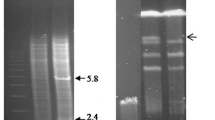Summary
The mutation xprD-1, previously shown to be an allele of the areA gene and to lead to nitrogen metabolite derepression in Aspergillus nidulans, is shown to be associated with a near terminal pericentric inversion in linkage group III. The left arm break-point is between the adI and sC genes, and the right arm break-point is between the ornC and areA genes but just centromere proximal to areA. In crosses of xprD-1 strains to inversion-free strains one class of duplication-deficiency progeny is recovered. These progeny have two copies of the distal portion of the left arm beginning just before sC but lack a copy of areA and the region distal to it on the right arm. The viability of these duplication-deficiency progeny indicates that no indispensable gene can lie distal to areA, suggesting proximity of areA to the telomere. The inversion might increase expression of areA which, given the positive acting nature of this regulatory gene, would result in nitrogen metabolite derepression. If increased expression be the result of fusion to (or creation of) a more efficient promoter and/or ribosome binding sequence, areA must be transcribed towards the right arm telomere.
Similar content being viewed by others
References
Arst HN Jr (1968) Genetic analysis of the first steps of sulphate metabolism in Aspergillus nidulans. Nature 219:268–270
Arst HN Jr (1981) Aspects of the control of gene expression in fungi. In: Glover SW, Hopwood DA (eds) Genetics as a tool in microbiology. Society for General Microbiology Symposium 31. Cambrige University Press, Cambridge, pp 131–160
Arst HN Jr, Bailey CR (1977) The regulation of carbon metabolism in Aspergillus nidulans. In: Smith JE, Pateman JA (eds) Genetics and physiology of Aspergillus. Academic Press, London, pp 131–146
Arst HN Jr, Cove DJ (1973) Nitrogen metabolite repression in Aspergillus nidulans. Mol Gen Genet 126:111–141
Arst HN Jr, Scazzocchio C (1975) Initiator constitutive mutation with an ‘up-promoter’ effect in Aspergillus nidulans. Nature 254:31–34
Chapon C (1982) Expression of malT, the regulator gene of the maltose regulon in Escherichia coli, is limited both at transcription and translation. EMBO J 1:369–374
Clutterbuck AJ (1974) Aspergillus nidulans. In: King RC (ed) Handbook of genetics, vol 1. Plenum Press, New York, pp 447–510
Clutterbuck AJ (1981) Loci and linkage map of Aspergillus nidulans. Aspergillus News Lett 15:58–75
Cohen BL (1972) Ammonium repression of extracellular protease in Aspergillus nidulans. J Gen Microbiol 71:293–299
Cove DJ (1966) The induction and repression of nitrate reductase in the fungus Aspergillus nidulans. Biochim Biophys Acta 113:51–56
Cove DJ (1976) Chlorate toxicity in Aspergillus nidulans. Studies of mutants altered in nitrate assimilation. Mol Gen Genet 146:147–159
Craymer L (1981) Techniques for manipulating chromosomal rearrangements and their application to Drosophila melanogaster. I. Pericentric inversions. Genetics 99:75–97
Grove G, Marzluf GA (1981) Identification of the product of the major regulatory gene of the nitrogen control circuit of Neurospora crassa as a nuclear DNA-binding protein. J Biol Chem 256:463–470
Hynes MJ (1975) Studies on the role of the areA gene in the regulation of nitrogen catabolism in Aspergillus nidulans. Aust J Biol Sci 28:301–313
Käfer E (1977) Meiotic and mitotic recombination in Aspergillus and its chromosomal aberrations. Adv Genet 19:33–131
Kelley RL, Yanofsky C (1982) trp aporepressor production is controlled by autogenous regulation and inefficient translation. Proc Natl Acad Sci USA 79:3120–3124
Mackintosh ME, Pritchard RH (1963) The production and replica plating of microcolonies of Aspergillus nidulans. Genet Res 4:320–322
Metzenberg RL (1979) Implications of some genetic control mechanisms in Neurospora. Microbiol Rev 43:361–383
Pateman JA, Kinghorn JR, Dunn E, Forbes E (1973) Ammonium regulation in Aspergillus nidulans. J Bacteriol 114:943–950
Perkins DD, Barry EG (1977) The cytogenetics of Neurospora. Adv Genet 19:133–285
Pontecorvo G, Roper JA, Hemmons LM, Macdonald KD, Bufton AWJ (1953) The genetics of Aspergillus nidulans. Adv Genet 5:141–238
Rand KN, Arst HN Jr (1977) A mutation in Aspergillus nidulans which affects the regulation of nitrite reductase and is tightly linked to its structural gene. Mol Gen Genet 155:67–75
Sherman F, Cardillo TS, Errede B, Friedman L, McKnight G, Stiles JI (1981) Yeast mutants overproducing iso-cytochromes c. In: von Wettstein D, Friis J, Kielland-Brandt M, Stenderup A (eds) Molecular genetics in yeast. Alfred Benzon Symposium 16. Munksgaard, Copenhagen, pp 154–174
Author information
Authors and Affiliations
Additional information
Communicated by W. Gajewski
Rights and permissions
About this article
Cite this article
Arst, H.N. A near terminal pericentric inversion leads to nitrogen metabolite derepression in aspergillus nidulans . Mol Gen Genet 188, 490–493 (1982). https://doi.org/10.1007/BF00330054
Received:
Issue Date:
DOI: https://doi.org/10.1007/BF00330054




